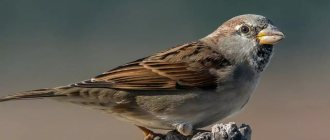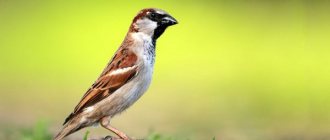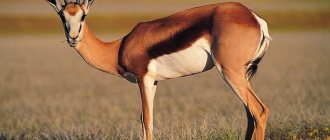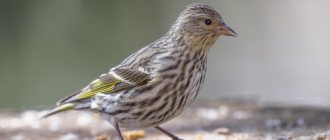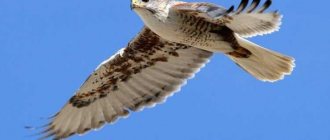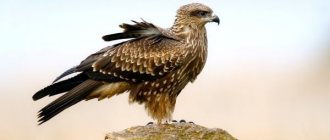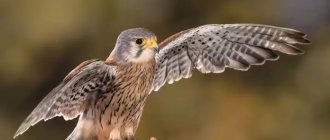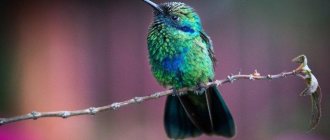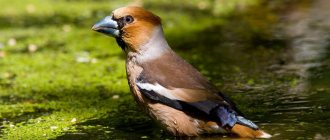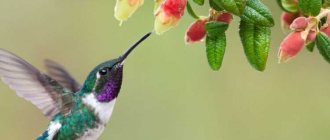Review author: “ZooVita”
This species of birds is distributed throughout the world. Today there is no corner of the planet where sparrows do not live. They settled even in Siberia and, of course, in the southern parts of the globe.
Despite the fact that the bird at first glance may seem inconspicuous and gray, the description of the sparrow is quite succinct. If you look at a photo of sparrows, you can easily see the beauty and uniqueness of the birds.
Features of the sparrow bird
Sparrows like to settle closer to humans. In cities, flocks of these birds gather on wires, tree branches, and in places where they can get more food. People are so used to their presence that they simply don’t notice.
In addition, sparrows are not very large individuals. On average, their body length reaches 10-15 cm. The weight is ridiculous - 30 g, no more. The wingspan alone is impressive. It is about 30 cm.
Population and species status
In recent years, ornithologists have noticed that the sparrow population has begun to gradually decline. Previously, huge flocks of birds flew, but now you can only see a few dozen individuals, and even then not in every yard. What is this connected with?
Sparrows are disappearing due to poor quality food filled with chemicals. Sprayed chemical fertilizers are increasingly being used on fields. Birds that eat grain from farm lands stop producing calcium in their bodies, which is necessary for the construction of eggshells. Also, soil and water pollution, intensive urban development, and an increase in mobile phone towers contribute to the reduction in the number of sparrows. This negatively affects the health and genetics of the birds.
Ornithologists say that in order to save sparrows, people must feed them with quality products and build birdhouses and feeders. Also, a person should monitor the purity of nature: do not throw away garbage wherever you want, also do not burn it yourself, since burning plastic is dangerous for the environment and living organisms, if possible, do not use pesticides, and treat nature with care. Scientists also claim that sparrows can be used as a biological device that can be used to determine the cleanliness of the environment.
Appearance of a sparrow bird
It is not a songbird, although the sparrow chirps shrilly. His loud voice can be recognized even in a noisy city.
At first glance, the plumage of the bird is gray and very inconspicuous, more brown tones. However, if you take a closer look at the individuals, you will notice more contrasting colors of the sparrow’s feathers.
Among them there are black ones, and very light ones - in the head area, on the neck. Moreover, the colors are quite varied in shades. Sparrows have a very powerful beak and a long tail.
External characteristics
The appearance of the sparrow bird is familiar to everyone. The bird is small in size, brown, gray in color with dark spots. The bird's chest and neck are different from the main color, but can also be gray and brown.
The sparrow's beak is dark and quite massive, and its tail is short. The average length of the bird is 15 centimeters, and its body weight rarely exceeds 40 grams.
If you look at the photo of the sparrow bird, you will notice that males have visible differences from individuals of the opposite sex. They are much larger than females, and males have characteristic dark spots on their chests.
Features of sparrows
On average, these birds live no more than 5 years. This bird cannot fly for more than 15 minutes. Despite the huge population of sparrows, scientists number about a billion individuals; many birds die before reaching 1-2 years of age. It's all about the cold and hungry winters. Often chicks fall out of the nest.
Male sparrows are an order of magnitude larger than their female companions. The stronger half has red spots on the chest and under the beak.
The short thin legs of these birds are practically not equipped with claws, which greatly distinguishes them from birds of prey and suggests that sparrows are far from aggressive in obtaining food. They feed on what is called pasture.
Sparrows: description
Nature is so diverse and numerous in bird species that in the natural environment there are quite a few species of birds that are similar to sparrows. However, not all of them belong to the passerine family or to the sparrow species. Scientists have identified 22 species of these birds, and 8 of them are most widespread and live around us.
These types include:
- The house sparrow is considered an inhabitant of the Euro-Asian continent and is distributed in almost all territories except the northern regions and tundra.
- The field sparrow is also common throughout Eurasia, as well as within North America.
- The snow sparrow mainly lives in the Caucasus and southeast Altai.
- The black-breasted sparrow is found in the more northern regions of the African continent and the Eurasian continent.
- The red sparrow is found on the Kuril Islands, as well as in the south of Sakhalin Island.
- The rock sparrow is a typical representative of Altai, Transbaikalia, the lower Volga region, and the Caucasus.
- The Mongolian ground sparrow is also considered a prominent representative of the western regions of Transbaikalia, the Republic of Tuva and the Altai Territory.
- The short-fingered sparrow prefers to nest in mountainous areas among stones and rocks, therefore it is found in Dagestan.
Appearance
The sparrow is a bird familiar to everyone, both adults and children. This is a small bird, which, at first glance, has a monotonous gray-brown plumage color, but if you look closely, you can find more contrasting tones, more dark or even black. The head, abdomen and ear areas are painted in light shades, and their intensity varies from light gray to light brown tones.
The sparrow has a powerful beak of a dark shade, and the tail is short and colored in the same tones. Sparrows grow up to a maximum of 15 centimeters, weighing no more than 35 grams. The wingspan of the bird reaches about 27 centimeters.
Interesting moment! The sexual dimorphism of these birds is quite pronounced. Firstly, males are noticeably larger than females, and secondly, females lack a bright spot in the front of the chin and on the chest.
The eyes of these birds have a barely noticeable border of gray-brown color. Sparrows have short, thin legs armed with weak claws. People mostly see house sparrows or tree sparrows every day.
These two species differ in the coloration of the males' heads. The male house sparrow has a peculiar gray cap on the crown of his head, while the male tree sparrow has a chocolate-colored cap. House sparrows have one light stripe on each wing, while the tree sparrow has two. The tree sparrow has black brackets on its cheeks, and a light stripe in the form of a “collar” runs around its neck. The house sparrow's body shape is rougher, with the house sparrow being much larger than the tree sparrow.
Interesting facts about Sparrows
Types of sparrows with photos
Almost all types of sparrows have their own characteristic differences compared to their relatives, for example:
Black-breasted sparrow (Passer hispaniolensis)
The black-breasted sparrow has a chestnut coloration on the head, neck, nape and wings. In the area of the back, bright light specks catch the eye, and the sides of the bird and cheeks are lighter in color. The throat area, crop, upper chest, as well as the strip separating the ears are black. A narrow, dark stripe runs across the wings. Males, compared to females, have brighter colored plumage.
Snow sparrow (Montifringilla nivalis)
The snow sparrow has long wings, painted in black and white, and a light gray tail, along the edges of which there are light feathers. This species has a characteristic black spot in the throat area.
Rufous sparrow (Passer rutilans)
They are distinguished by their basic, bright chestnut color, which is characteristic of the back, wings, and the back of the head. Females differ from males in that their chest area is colored in light gray or light brown shades.
Stone sparrow (Petronia petronia)
The stone sparrow has a wide, light stripe in the crown area, and the beak has a light brown tint. The chest and throat area are painted in light colors, with clearly visible streaks. The goiter is characterized by the presence of a large lemon-yellow spot.
Mongolian ground sparrow (Montifringilla davidiana)
It is distinguished by the usual color of its gray plumage, with the presence of barely noticeable light spots.
Short-toed sparrow (Carpospiza brachydactyla)
The short-toed sparrow has a sandy plumage color, and feathers of lighter colors can be seen in the central part of the throat and at the tip of the tail.
Interesting to know! Scientists believe that sparrows see this world in pink shades, and in the cervical spine these birds have 2 times more vertebrae than a giraffe.
Behavior and lifestyle
These birds have a rather quarrelsome character, especially since they always defend their rights to territory with great dedication. At the same time, they arrange showdowns, both with other birds and with their relatives, and do not arrange bloodshed. Quite often, smaller species of birds cannot resist the pressure of sparrows and leave their habitats.
As a rule, sparrows lead a sedentary lifestyle and always make nests in the same place. Flocks of sparrows consist of adult birds, as well as young ones, since the offspring, even after reaching sexual maturity, remain with their parents. Sparrows choose a sexual partner once and for life. These birds nest in various abandoned outbuildings, both in cities and villages. If possible, they easily settle in the hollows of old trees, in abandoned swallow nests or in birdhouses.
The natural habitats of tree sparrows are associated with forest edges, parks, gardens, and densely growing green spaces. Often their nests can be seen in the walls of the nests of large birds such as storks, herons, eagles, ospreys, etc. In such conditions, sparrows feel safe, since these large and predatory birds can easily fend for themselves and their offspring, and at the same time protect the sparrow family. Silence and peace for these birds are incompatible concepts, but a lot of noise, hum, in the form of chirping, these are the conditions that suit these birds. This is especially true in relation to the spring period, when birds form pairs.
Each flock is characterized by the fact that they have their own guard sparrow, which protects the flock from approaching danger. In case of danger, this guard makes a characteristic sound, familiar only to sparrows, after which the flock seems to be blown away by the wind. If a cat appears nearby, the birds organize a real “bazaar”, which can be heard from many tens of meters away. They also behave if the chick falls out of the nest.
Interesting moment! Many people know that sparrows have a rather thieving character, which is associated with one of the popular versions of the name of the bird, although many of these versions have nothing to do with the name.
How long do sparrows live?
Sparrows have a fairly short life, since on average they live no more than 4 years, although older individuals are also found.
Natural habitats
Each species of sparrow is characterized by its usual habitats, although they can hardly be found in areas where it is very cold and where there is practically no life. If we exclude cold regions, then sparrows can be found anywhere on our Planet.
We can safely say that where a person lives, there are sparrows. They nest in Australia, as well as in forest-tundra conditions. Therefore, there are quite a few places on the Planet where sparrows are not found.
What do they eat
Sparrows are unpretentious birds in food, since they can eat the remains of human food products, various crumbs, insects, worms, as well as grains of various crops. Sparrows are not very afraid of people, so they can easily steal something tasty from the table, although this happens in cases where there is a lack of food.
Important point! In winter, sparrows often suffer from a lack of food, especially in cold and snowy winters. Therefore, many of them die from hunger.
It should be noted that they can always share food with all members of the pack. If the food is unfamiliar to them, then the sparrows are unlikely to covet it.
Reproduction and offspring
At the beginning of March, when the sun really begins to warm up, the sparrows also come to life, making a lot of noise in the form of endless chirping. We can safely say that the birds are preparing for the mating season. Males fight for the right to own a female. After pairs form, nest construction begins by the end of March.
In April, couples begin to lay eggs and their number can reach 8 pieces. The eggs are white in color, but with red spots and inclusions. For two weeks, the couple incubates the future offspring, and they do this alternately.
Both parents are involved in feeding their offspring after the chicks are born. Thanks to the efforts of both parents, the chicks grow quickly and eventually fly out of the nest. Even after this, the parents continue to care for the chicks, although they are already beginning to lay eggs for the next brood. Under certain conditions, the number of clutches can be three throughout the year.
Natural enemies
Like many other species of small birds, sparrows have a sufficient number of natural enemies. The greatest danger is posed by stray cats, which easily catch unwary individuals. Sparrowhawks hunt various birds during the daytime, and sparrows are no exception. At night they are watched by owls.
Types of sparrows
People are used to seeing either house sparrows or tree sparrows. They differ. The house bird “wears” a rounded gray cap, while nature has endowed the field bird with a brown cap.
House sparrows have a light feather on their wings, while field sparrows have two on each. And they also have a light collar on their neck, which also distinguishes this species from the brownie.
Why was it called "Sparrow"
It is believed that the name of the bird comes from the ancient Slavic word “gorobets”, which means “pockmarked”. Considering that the sparrow’s color has many areas where there are black and gray spots on a brown background, it could have gotten its name based on just such a feature.
Interesting: Flies: nutrition, vision, smell, danger, benefits, types, photos and videos
There is also an opinion that the bird was so nicknamed because of the sounds it makes. The sparrow communicates with trills similar to “vrk-vrk.” This sound is similar to the ancient word “vork”, which means “to grumble”, “to coo”.
Habitat of sparrows in the wild
It is believed that the homeland of these birds is Southeast Asia. But gradually they settled all over the world. Sparrows today are regulars in Australian cities, have even become comfortable in Yakutia, and live in the tundra. Flocks of these birds have settled everywhere. They can be observed in large cities and rural areas.
Behavior and lifestyle
Sparrows are very smart birds. A. Bram wrote about them like this: “Although the sparrow at first glance seems stupid, in reality it is richly gifted. Being very intelligent, he little by little becomes so familiar with a person and his way of life that he surprises every observant person.” “They are also gifted with excellent memories.” The sparrows (field sparrows), which constantly feed on the feeder installed on our site, recognize me (their main “feeder”) very well. More likely, even my jacket and snow shovel. And if our dog leaves the house, then all the sparrows instantly flock to the feeder. They have developed a strong conditioned reflex to a combination of three factors: a purple jacket, a shovel and a dog. Birds sit on bushes and trees near the feeder and calmly wait for a new portion of food to appear in the feeder.
Tree sparrows
Bram writes: “The characteristic feature of the sparrow is that wherever it is found, it lives in the closest communication with man. It inhabits both noisy, crowded cities and secluded villages surrounded by fields. Ships bring him to islands where he was never known before; he remains to live on the ruins of devastated areas, as a living witness to the happy past. Being in the full sense of the word a sedentary bird, he almost never flies beyond the boundaries of the city or beyond the borders of the fields where he was born; only occasionally does he undertake travel to explore the region beyond the areas where he lives.” Everything is exactly like that. In recent years, we have formed a huge, close-knit flock of sparrows. It's funny to see thin first-year birds who cautiously give way to older birds.
Bram continues: “... just like with a person, he enters into more or less close relationships with other creatures: he is trusting or distrustful of a dog, he is very annoying to horses, he warns his own kind and other birds about the presence of a cat, he steals food from chickens, not paying attention to their threatening movements.” I once observed the interesting behavior of sparrows hiding from a neighbor’s cat in a wide bush next to a feeder. The whole flock found itself inside a huge green ball, but at the very top one of the sparrows was on duty all the time. This “watchman” cautiously watched the cat and from time to time dived into the bush to tell the other birds something. I drove the cat away, and the sparrows immediately returned to eating.
The benefits that sparrows bring and the harm attributed to them are eloquently evidenced by the experience of China during the Great Leap Forward (1958-1960). It all ended with the sparrows being completely exterminated. Then hordes of pests attacked the ripening grain. The state had to urgently import sparrows from other countries.
Bram very accurately noted that sparrows crowd out other useful birds “and with their pugnacity, their restless disposition, they discourage songbirds from visiting the gardens that they have taken possession of.” This is unfortunately true. It’s been two years now that tits are almost invisible on our site. Neighbors list to me the birds that come to their feeders. But our “bandits” drive away all small birds (especially tits) that find themselves within the sparrow’s territory. And what kind of fights they staged last year with swifts, not wanting to give up their nests to the birds that arrived.
And one more interesting observation by Bram: “Sparrows are difficult to tame. But in some cases it is possible to attach this smart bird to yourself. Roveler reports that one of his acquaintances managed to tame a female sparrow in complete freedom; he flew to his name, sat on the lap and hand of his owner and recognized him from afar.”
Types of sparrows that exist on the planet
In nature there are a huge number of birds similar in appearance to the sparrow, but they have nothing in common with it. Scientists have identified only 22 species of sparrows, eight of which are the most common. The brownie and the field live everywhere. Besides them there are:
- Snow sparrow. It is found in Altai, on the territory of the Caucasian republics.
- The black-breasted or black sparrow is common on the African continent, less common in Eurasia.
- Red birds, also called red sparrows, settled in the Kuril Islands and Sakhalin.
- The stone sparrow lives in the Transbaikal region, Altai, Caucasus, and Volga region.
- The Mongolian type can be found in Tuva and Altai.
- Shortpaw lives in Dagestan.
Where does the sparrow live?
Photo: Moscow sparrows
It’s easier to list those places where you won’t see a sparrow, because... It lives almost everywhere, although the sparrow does not like an overly frosty climate. The sparrow can be called a human companion; it gets along well both in rural areas and in huge metropolitan areas.
Sparrows have settled in the tundra, forest-tundra, and on the Australian mainland. The distribution range of sparrows is very extensive. It covers territories from the western part of Europe to the Sea of Okhotsk; the sparrow is found in both Central and East Asia; this bird has not bypassed Mother Siberia.
The specific distribution area can be designated for each variety:
- the house sparrow is an indigenous inhabitant of Eurasia, found everywhere in our country, with the exception of its northeastern part and the tundra;
- the snow sparrow inhabits the Caucasus and the southeast of the Altai Territory;
- the field sparrow is distributed throughout Eurasia and North America;
- the red sparrow on Russian territory has chosen the Kuril Islands and the south of Sakhalin;
- the Mongolian ground sparrow is found in Transbaikalia, the Republic of Tuva and Altai;
- the black-breasted sparrow lives in the north of the African continent and in Eurasia;
- the stone sparrow is registered in the Altai region, on the lower Volga, in Transbaikalia, in the Caucasus;
- The short-fingered sparrow inhabits Dagestan, because prefers mountain rocky areas.
It would seem that sparrows live everywhere, they can be seen sitting on the roof, on a tree branch near the window, just flying by, fighting near the feeder, jumping on the asphalt, chirping in the garden, living in the field. We are so accustomed to these small birds that for us a sparrow is considered something (someone) ordinary and everyday.
Lifestyle of sparrows
In winter, sparrows do not leave their usual habitats, but from time to time flocks of these birds look for new territories to live in. By the way, these birds are far from stupid; they have a developed memory. Scientists have studied their habits and concluded that sparrows are even capable of building logical chains.
These are pugnacious, very harmful creatures that are practically not afraid of anything. The sparrow's main enemy is the cat, but they manage to outwit them too, and often tease them by flying close to the windows of residential buildings and, seeing a cat on the windowsill, hover for a while, floating in the air.
Sparrows are capable of fighting for their territory with other species of birds. Even crows often avoid flocks of sparrows; they do not want to get involved with these immensely conflicting creatures.
In winter, sparrows are not so nimble, they gather more in flocks, but in summer they constantly start fights among themselves. The reason is females or a cozy nest built and occupied by a relative.
Habitat
There are about 35 species of sparrows in nature. Each of them has its own external distinctive features and habitat. You can meet these birds everywhere, except for cold continents, where life is practically absent.
Birds are not picky about anything. They follow a person wherever they go. They easily found refuge in Australia and developed the territory of the tundra and forest-tundra. Places where, to put it mildly, life does not seem like a fairy tale to everyone. There are very few places left that are not inhabited by these birds.
Sparrow bird diet
These birds are very unpretentious. They pick up crumbs and seeds that compassionate citizens throw at them. Sparrows often “graze” near garbage cans and are capable of stealing delicious food from a market stand.
It is believed that it is because of this that he is called a sparrow, like “beat a thief.” The most desirable delicacies for sparrows are insects, worms, grains, and berries.
Sparrows destroy harmful insects, so in villages wild flocks are allowed to feast on grains carefully grown in the fields. And bird repellents don’t work on them, so people have to put up with such impudence.
They always share food with their relatives, but if the food is unfamiliar, none of the flock dares to try it until one of the sparrows decides to taste the unknown delicacy. If everything is in order, the whole flock will start eating loudly and quite quickly.
What does a sparrow eat?
Photo: Sparrows in winter
The sparrow can be called an omnivore; this little bird is unpretentious in food. The sparrow's menu consists of crumbs, various grains, insects, berries, fruits, and leftovers from a human meal. A sparrow cannot be called very shy. Many have probably seen these nimble birds begging for food at train stations from passengers waiting for their transport.
People break off pieces of buns and pies for them, and a whole flock of sparrows try to separate them, because they are not at all greedy. Sparrows, without shyness, guard the remains of some food in summer cafes, and can steal a tasty morsel from the table. They treat new, unfamiliar food with caution, carefully examining it, and, often, they will not eat it at all.
In winter, birds have a hard time; large numbers of them can be seen at the feeders. Moreover, often when a flock of sparrows appears, the tits fly away, such is the robber and lively character of sparrows.
In winter, during severe frosts and heavy snowfalls, many sparrows die because they have nowhere to find food, so people should take care of the birds by placing feeders with food.
In the village in the summer, sparrows live simply wonderful. The gardens are full of food for them. Sparrows are very fond of cherries, currants, and grapes. Often gardeners and gardeners complain about them because they peck a lot of berries. On the other hand, sparrows destroy many pests that cause damage to the crop.
It should be noted that driving sparrows out of the garden with the help of a scarecrow is a useless task; the bird is not at all afraid of it. This is how the sparrow has a varied menu, largely depending on human preferences.
Sparrow breeding
Sparrows are monogamous. In the spring, couples build nests, but more often they try to take someone else’s house. They set up their huts in niches and under the roofs of houses and even in small chimneys, on ledges. During the season, a female sparrow hatches up to 3 clutches.
The first offspring, depending on the climatic conditions of the region, are born in early spring. Last nesting is in August. The clutch consists on average of 6-7 eggs.
Incubation lasts no more than a week, and then the parents take care of the chicks, trying to bring them everything delicious: grains, insects, berries. For a month, the babies are raised and cared for by both parents as equals. The children fly out of the nest, and the couple has new offspring.
Social structure and reproduction
Photo: Pair of sparrows
As already mentioned, the sparrow is a flocking, sedentary bird that lives in a certain territory, which does not tolerate encroachment. Sparrows have very strong pairs; birds create a family union until the end of their days. Pair formation usually begins in the very last days of winter or early spring.
Then sparrows chirping and restless chirping are heard everywhere. Gentlemen, seducing ladies, often get into fights, so scandals during the marriage period are inevitable. The newly minted couple begins building a nest, which is already completely ready towards the end of March. The sparrow's nest is small, rough, made of straw, small branches, feathers and dried grass.
In April, the female begins to lay eggs, usually their number does not exceed 8. They are white in color and strewn with reddish-brown specks. Both parents take turns incubating the eggs, the whole process lasts approximately two weeks. Hatched chicks are born almost naked, their fluff is sparse, and their large yellow mouth is immediately noticeable. Sparrows are very caring parents who feed their babies together, tirelessly bringing them all kinds of insects.
The period of such feeding lasts a little more than two weeks. When the babies are only 10 days old, they are already beginning to make their first flights. Towards the end of May or at the very beginning of summer, young sparrows begin to leave their parental nests. Having left the nest, the young remain in the flock, subsequently forming their own families. The parents soon begin creating a new clutch again; over the summer there may be several of them (about three).
Surprisingly, in late autumn there is a revival among the sparrows, loud chirping, and courtship with the females resumes. The birds are again starting to build nests, the offspring of which are expected only next spring, and these cozy, pre-prepared structures will serve as a refuge from winter and autumn bad weather.
Enemies of sparrows in the wild
These birds have plenty of them. The biggest danger comes from cats. In villages and far from cities, the main threat to these birds is hawks, and at night owls lie in wait for sparrows.
Danger
Despite the dexterity, arrogance and nimbleness of birds, sparrows have many enemies. Stray, hungry cats can calmly catch unwary individuals.
During the day they are hunted by large, predatory birds, such as hawks, and at night they are attacked by owls.
Despite the fact that there are simply a huge number of sparrows in nature, they still have benefits.
Like any other animal or bird, the sparrow is an important link in the food chain, so only humans can protect this species of birds.
Photos of all types of sparrow birds
Food
These birds are not picky in their choice of food. Sparrows love to eat grains, waste from human food, beetles, and ants.
Very often you can see a picture of a bird sitting near a person and waiting for him to treat him with something. Cases of theft cannot be ruled out, when unwary people were deprived of this or that food that a bird could carry away.
Sparrow at home
Keeping a sparrow at home is, as a rule, not accepted. However, no one will pass by a chick that accidentally fell out of the nest. Naturally, he will be taken home to be nursed, and now the small adult bird remains to live in a cage in which, by the way, he feels more than comfortable. Representatives of the sparrow family easily get used to captivity and remain calm in the cage. However, the ease of taming a sparrow very much depends on the type of particular bird. Thus, tree sparrows are not tractable in this regard, but stone sparrows, on the contrary, quickly get accustomed to a new house with twigs.
How to maintain a home
One of the most important points in keeping a sparrow at home is keeping the animal occupied in the cage. Therefore, their cages are often equipped with many different perches, twigs, bushes, dry snags and other little things that a bird can occupy its time with. Otherwise, a small-looking sparrow can cause a lot of trouble.
Sparrows show a special love for water, and will never refuse good water treatments. Therefore, placing a large bowl of water in the cage in which the sparrow can bathe will cause real delight in the bird.
Sparrow in arms
What to feed at home
Not only the conditions of keeping a sparrow in captivity have an impact on life expectancy, but also the quality of food. Fortunately, today this question does not cause much confusion, since almost everything can be found in modern pet stores. Including specialized food for sparrows. You will have to feed the bird often; this food must be poured at least every two hours.
In addition, birds must be provided with food of animal origin. For example, live insects; getting these will not be an impossible task for fishermen. Sparrows also feed on boiled eggs, raw meat, grated fruits and vegetables. But the latter is best given rarely as a treat.
The moment of filling winter feeders, which are often located in many yards, deserves special attention. Contrary to popular belief, it is better not to give bread crumbs to these birds, since they cause great harm to the sparrows’ digestive system. But both the birds themselves and their digestive systems will thank you for the cereals, seeds and pieces of lard.
The word is not a sparrow
Natural enemies
Despite their fighting nature, sparrows have many enemies in nature. The most dangerous of them are stray cats. They are able to catch “onlookers” and then eat them. During the daytime, sparrows are a target for sparrowhawks, which can suddenly fly out from behind a house or trees that serve as cover for them, and pounce on unsuspecting birds. At night, owls are the enemies of sparrows.
Return to content
Interesting facts about the bird
- A closely related species called the Italian sparrow lives in Italy.
- In 1950, about a hundred sparrows lived in Vorkuta. When it was cold, they spent the winter in the boiler room and flew out to the dining room to feed.
- The house sparrow's heart beats 700 times per minute (at rest). During flight, the beat reaches 1000 beats per minute.
- Granivorous birds starve longer than those that feed mainly on insects. Seeds take 4 hours to digest, beetles take about an hour.
- Several species of the passerine family are listed in the Red Book of Russia. These include the Mongolian lark, shaggy nuthatch, Jankowski's bunting, and common gray shrike.
What they look like
The sparrow is a small bird and its body length does not exceed sixteen centimeters and its weight is thirty-five grams. The wingspan of the small bird is also small, only twenty-seven centimeters.
The baby's plumage is tricolor: gray, brown and black. This is if we are talking about the back, head and wings, but the abdomen is grayish-green. A distinctive feature of sparrows is their cone-shaped beak, as well as a truncated tail. The sparrow's legs are quite weak and do not have powerful claws.
Sparrow sits on the rebar
What do sparrow nests look like?
Sparrows choose places for their nests that are, to put it mildly, peculiar. For such purposes, cracks in buildings, roof eaves, clay burrows, thickets of bushes, and hollows in trees are perfect for them. And even the houses of other birds are suitable as nests for them.
In a pair of sparrows, both the female and the male are equally involved in the nest. Although nest construction is not approached as if it were something very important. Their nests may be uneven, with holes in the walls, or completely dilapidated.
For building materials, sparrows usually use various blades of grass, straws, twigs, and leaves. In general, almost everything that these little ones can carry in their beaks. Since these birds are not large in size, their nest will be correspondingly small. The diameter of a sparrow's nest does not exceed twelve centimeters, and its depth is no more than seven centimeters. Birds usually cover the bottom of the nest with feathers, and the entrance is located on the side.
Tree sparrow nest in straw
